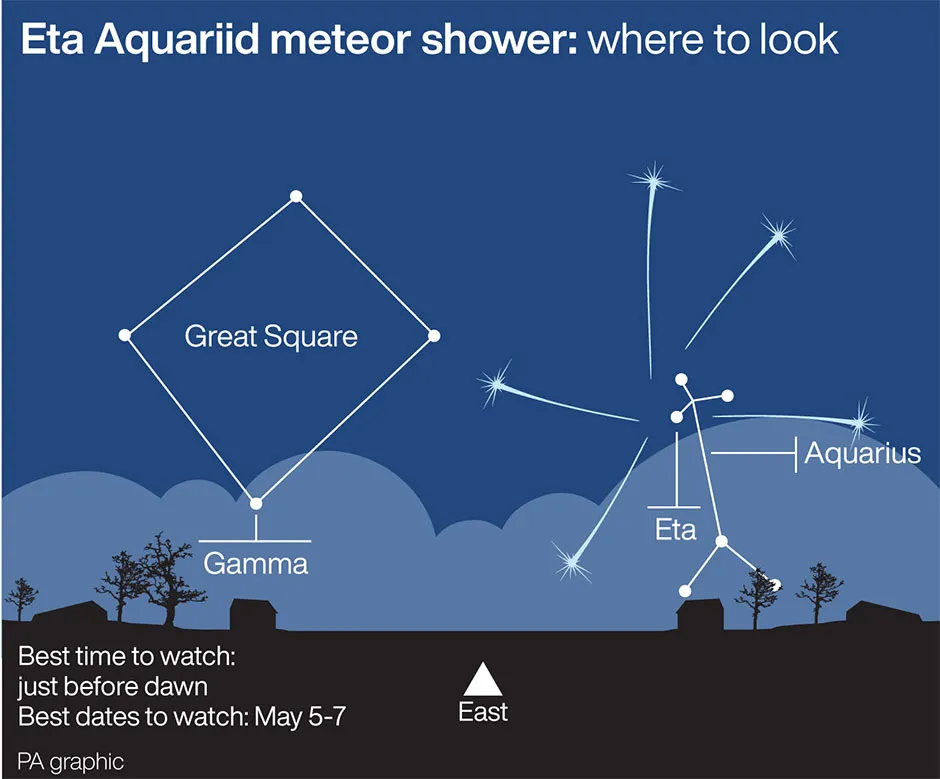Stargazers can look forward to seeing several shooting stars on Tuesday night, as the Earth passes through the dust left over from Halley’s Comet.
The Eta Aquariid meteor shower is expected to peak on the night of 5 May, with up to 40 meteors per hour, and will be visible until the early morning of 6 May. This celestial display is associated with the Halley’s Comet, officially designated 1P/Halley, which orbits the Sun once every 76 years.
Tania de Sales Marques, an astronomer at the Royal Observatory Greenwich, told the PA news agency: “The last time [Halley’s Comet] was seen in the sky was 1986, and our next chance to view it will be late in the year 2061.”
Read more about garden astronomy:
- How do I see the Super Flower Moon this week?
- A beginner's guide to stargazing, no telescope required
Meteor showers are named after their radiant, that is, where they appear to originate from in the sky. The Eta Aquariids, for example, appear to come from the constellation of Aquarius in the southern hemisphere.
Meteoroids from Halley’s Comet strike the Earth’s atmosphere at an approximate speed of 150,000 miles per hour (240,000kph), burning up in the process.
De Sales Marques told PA: “As a comet approaches the sun it heats up, releasing gas and dust into space behind it.
“When that wake of debris intersects with the orbit of the Earth we experience meteor showers, as the particles fall towards the Earth and heat up upon entering the atmosphere, leaving bright streaks in the sky as they vaporise or break apart.”
While the Eta Aquariids is active from late April to near the end of May, Ms de Sales Marques says the best time to see it will be on the night of 5-6 May between midnight and sunrise, when the shower will be at its peak.

De Sales Marques told PA: “This is a moderately active meteor shower, with a peak rate of 40 meteors per hour, and even though its radiant [where they appear to originate from] will be below or only just above the horizon for those of us at London’s latitude, we can still look out for its meteors all across the sky.
“Our best chance will be in the hours just before dawn, facing the eastern sky.”
She advises getting far away from all artificial lights to increase the chances of catching a glimpse of the shooting stars on a moonlit night.
De Sales Marques said: “As with any other stargazing activity, the best way to see meteors is to find yourself a spot sheltered from city lights with an unobstructed view of the sky and look in the direction of the radiant.
“The Moon will be waxing gibbous throughout the night, so the sky won’t be as dark as one could hope, adding to the challenge.”
Reader Q&A: How do we predict meteor shower intensity?
Asked by: Simon Foster, Burnley
Most ‘predictions’ of the rate of meteors per hour during meteor showers are based on both theory and observation. Essentially, a computer model is built containing the trajectories of every known comet – since it is the debris from comets that forms the ‘stream’ of particles we see during a meteor shower.
This model contains information on the rate that these comets release material, along with the sizes, directions and velocities at which they are released, as well as the gravitational forces that determine their subsequent trajectories through space. The trajectory of the Earth and the conditions of the Earth’s atmosphere are also inputted into the computer model.
By watching how Earth moves through the meteor stream it is possible to estimate the likely number of meteors that will be visible during a given shower for a given location.
But different astronomers use different models. Plus, these models are partly based on difficult measurements of the meteoric particles in the Solar System, so their predictions are often only approximate.
But generally, they can be used to reliably predict when a meteor shower is likely to be more or less intense than the average.
Read more: